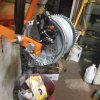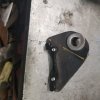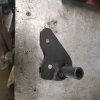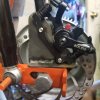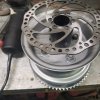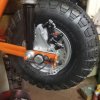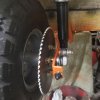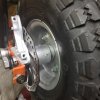Charles: From your comments, I suspect you believe some material was removed from my brake disc as a result of polishing. That's not the case! The "contours" of which you speak are exactly as they were prior to polishing. It is my understanding that these contours are "rounded" in such a fashion so as to prevent sharp edges from damaging the brake pads; at least that's how I remember it. I have to say, these discs must obviously be made of a fairly hard alloy. Believe me, it would take more severe grinding than the polishing we did to change the configuration of this disc. As to the reduction in braking efficiency resulting from the polishing?.........IMHO, the difference may not be as noticable as we think; particularly after a short period of use.
Further (and in contrast to the above), I definitely agree with your view as to how much more effective these calipers could prove to be; especially when used on the small diameter wheels (as opposed to the large diameter bicycle wheels) that we generally see on a mini bike.
All the best, Henry
P.S. BTW, my middle name is Charles (ha)


